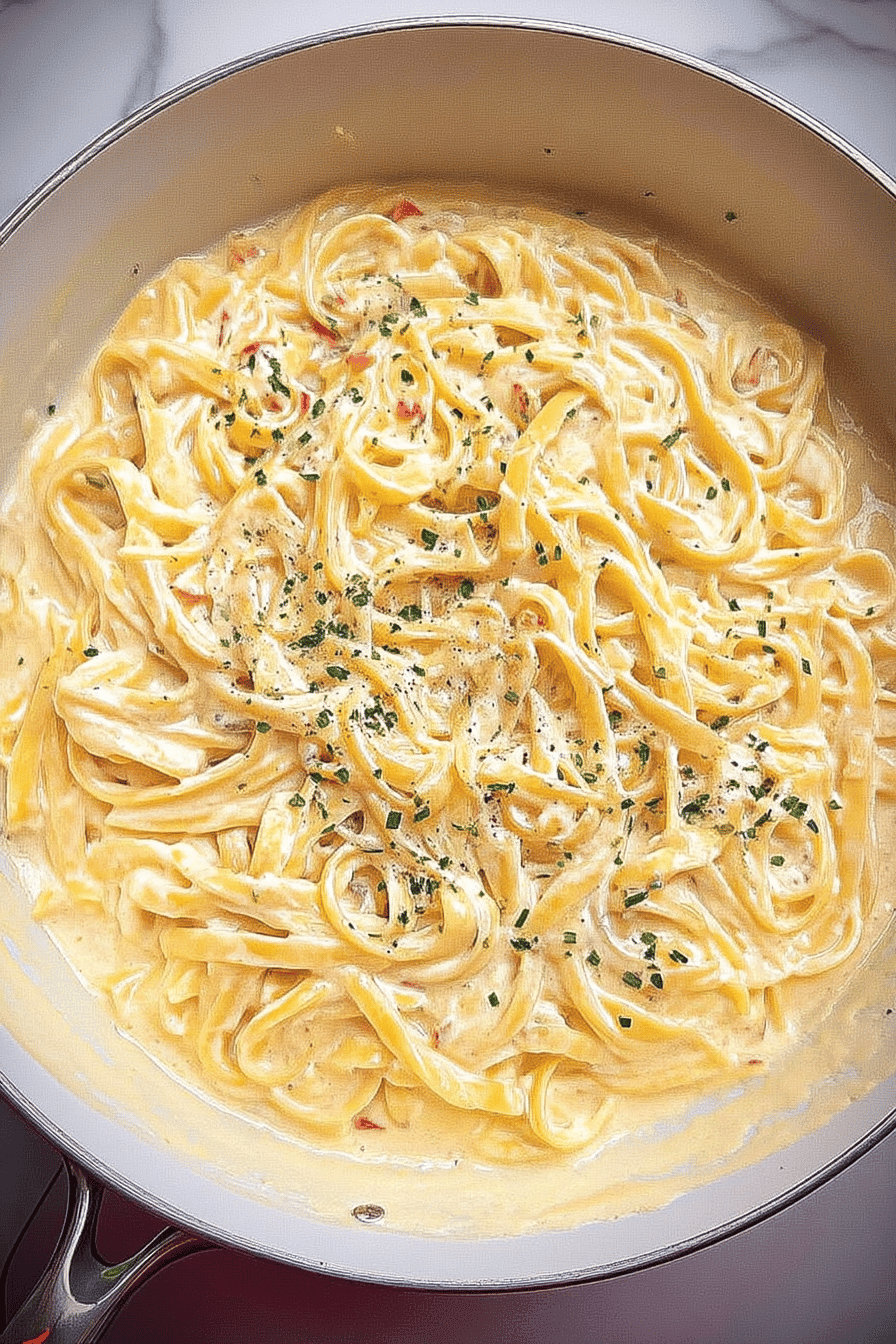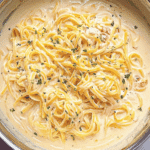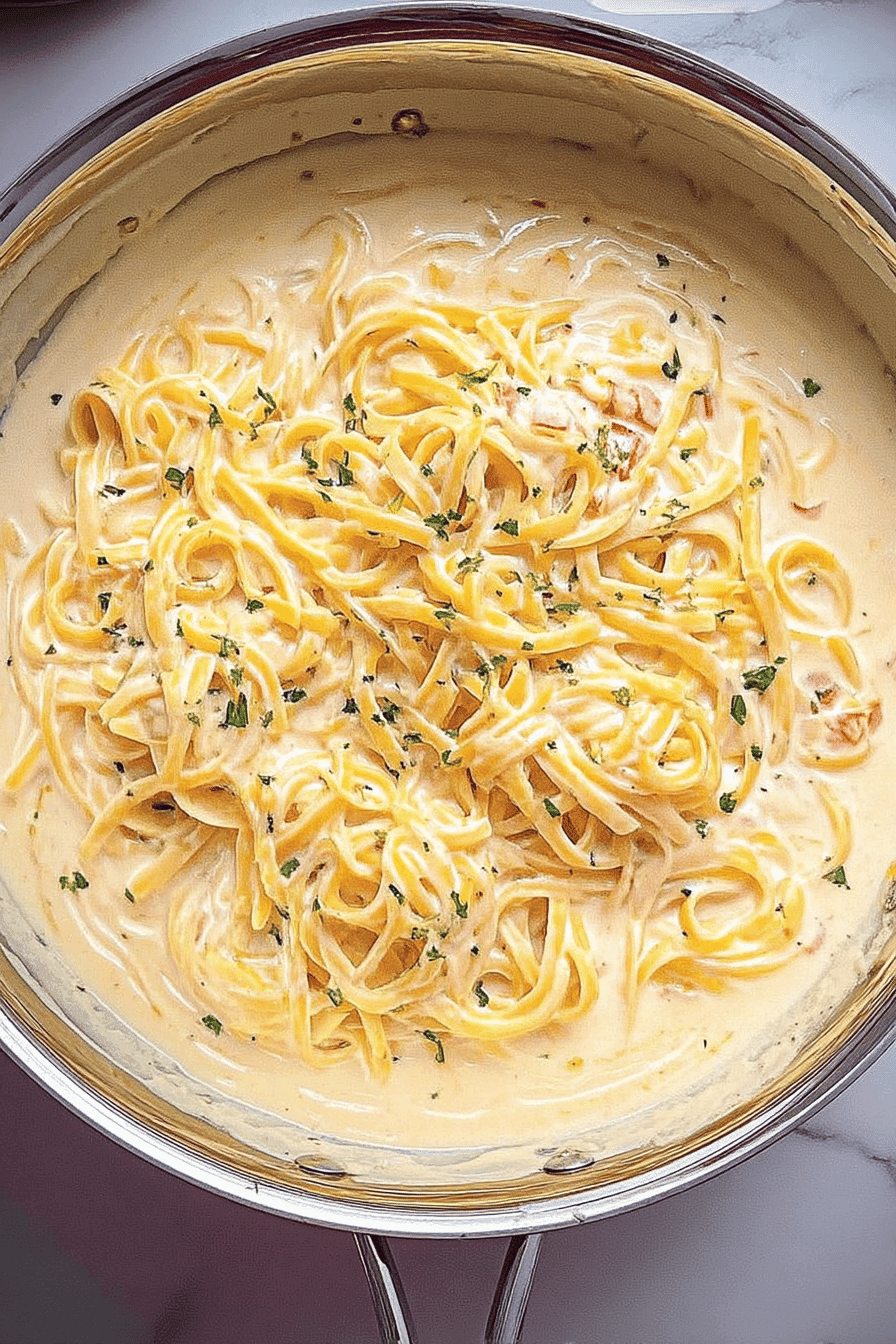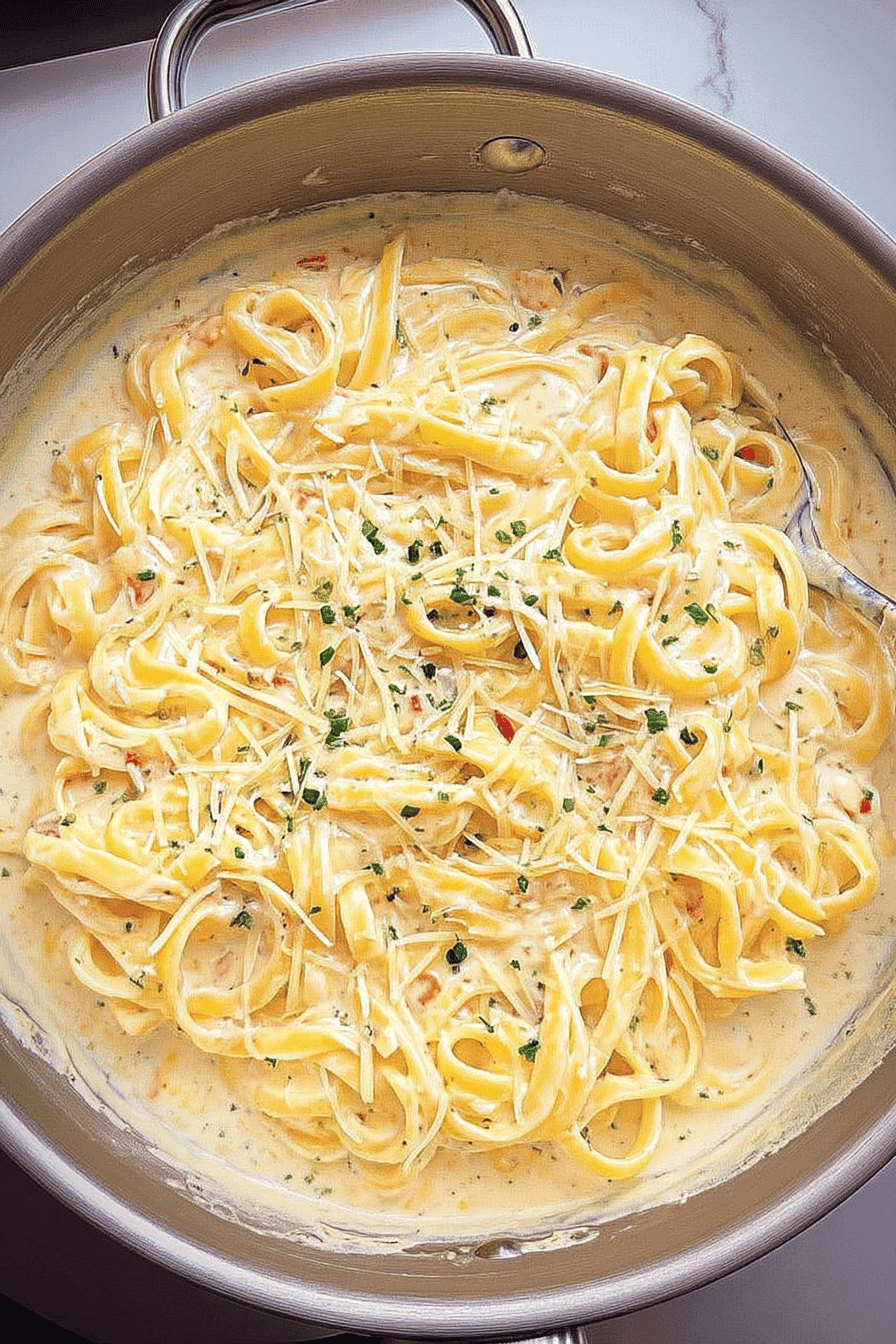Benefits and Advantages of cajun alfredo sauce
This cajun alfredo sauce recipe offers several advantages that make it a standout choice for both novice and experienced cooks. Its ease of preparation means you can whip up a flavorful sauce in a short amount of time, perfect for busy weeknights or last-minute dinners. The recipe uses straightforward ingredients, making it accessible without compromising on taste. Additionally, it provides health benefits by incorporating optional low-fat and gluten-free ingredients, allowing it to fit into diverse dietary plans.
The blend of bold Cajun spices with creamy Alfredo sauce presents a unique flavor profile that adds excitement to traditional pasta dishes. This sauce also allows for customization, which is great for accommodating different dietary preferences such as vegan or low-calorie options, making it both versatile and inclusive. Overall, the cajun alfredo sauce stands out by combining simplicity, health consciousness, and rich, spicy flavor to complement and enhance any meal effortlessly.
Jump To
- 1. Benefits and Advantages of cajun alfredo sauce
- 2. Essential Ingredients for cajun alfredo sauce
- 3. Dietary Substitutions to Customize Your cajun alfredo sauce
- 4. How to Prepare the Perfect cajun alfredo sauce: Step-by-Step Guide
- 5. Advanced Tips and Variations
- 6. How to Store cajun alfredo sauce: Best Practices
- 7. Nutritional Value of cajun alfredo sauce
- 8. FAQs: Frequently Asked Questions About cajun alfredo sauce
- 9. cajun alfredo sauce
Essential Ingredients for cajun alfredo sauce
- ½ cup (about 113g) unsalted butter
- 1 shallot, finely diced
- 3 cloves garlic, minced
- 1 ½ to 2 cups (360-480 ml) heavy whipping cream
- 1 cup (about 90-100g) freshly grated Parmesan cheese
- 1 tablespoon Cajun seasoning* (blend typically includes paprika, garlic powder, onion powder, oregano, thyme, cayenne pepper, salt, and black pepper)
- Optional: 1 tablespoon dry white wine for deglazing
- Optional: lemon juice or zest to brighten flavor
- Optional: 2 tablespoons chopped fresh parsley, chives, or green onions
These ingredients work together to create the rich, creamy texture and bold, spicy flavor that define cajun alfredo sauce. Be sure to use freshly grated cheese and high-quality Cajun seasoning for the best taste results. For vegan or health-conscious adaptations, substitute heavy cream with coconut or cashew cream, butter with vegan butter, and Parmesan with nutritional yeast.
Dietary Substitutions to Customize Your cajun alfredo sauce
For those catering to specific dietary needs, this cajun alfredo sauce recipe offers numerous substitutions. Vegan diets can opt for coconut cream or cashew cream instead of dairy cream, and plant-based butter in place of regular butter. Nutritional yeast serves as an excellent replacement for Parmesan cheese to maintain the cheesy flavor without animal products.
To accommodate gluten sensitivities, ensure your Cajun seasoning and any additional thickeners are gluten-free or use naturally gluten-free cornstarch for thickening. For lower-calorie versions, light cream or unsweetened almond milk can replace heavy cream, while reducing the amount of butter helps decrease saturated fat content. Additionally, herbs like fresh parsley or basil can enhance flavor without adding calories. These substitutions keep the sauce flavorful and versatile, allowing it to fit seamlessly into various eating plans without sacrificing the distinctive Cajun Alfredo taste.
How to Prepare the Perfect cajun alfredo sauce: Step-by-Step Guide
- Melt the butter: In a medium saucepan, melt the butter over medium heat carefully to avoid burning. For vegan preparations, substitute with vegan butter.
- Sauté shallots and garlic: Add minced shallot and garlic to the melted butter and cook until translucent and fragrant, about 2-3 minutes. Avoid browning the garlic.
- Add Cajun seasoning: Sprinkle in the Cajun seasoning blend, stirring it in to release its aromas. Adjust the amount according to your spice preference and dietary tolerance.
- Deglaze (optional): Add dry white wine to deglaze the pan, scraping any browned bits, and simmer until the alcohol evaporates.
- Incorporate heavy cream: Pour in the heavy cream slowly, stirring continuously to combine well. For dietary adjustments, use coconut cream or a milk alternative if preferred.
- Simmer the sauce: Bring the mixture to a gentle simmer, allowing the sauce to thicken, stirring often to prevent scorching.
- Add Parmesan cheese: Gradually whisk in grated Parmesan cheese, or nutritional yeast for a vegan version, until fully melted for a smooth, creamy texture.
- Season: Add salt and freshly ground black pepper to taste, adjusting for sodium restrictions if necessary.
- Finish the sauce: Remove the sauce from heat once it reaches the desired consistency. For thicker sauce, simmer a bit longer or add a cornstarch slurry for gluten-free thickening.
- Serve: Toss immediately with your preferred cooked pasta or dish, or keep warm on low heat until ready to use.
This method produces a rich, creamy sauce with a spicy kick that complements a variety of dishes elegantly and simply.
For more detailed guidance on creating classic Alfredo sauce, visit How to Make Alfredo Sauce. To understand more about the spices used, check out What is Cajun Seasoning.
Advanced Tips and Variations
To deepen the flavor of your cajun alfredo sauce, try lightly toasting the Cajun seasoning in the pan before adding the liquids. This step releases the spices’ essential oils, enhancing aroma and complexity. Adding finely diced shallots or caramelized onions during the sauté phase brings subtle sweetness to balance the spice. For a lighter sauce, replace half of the heavy cream with chicken or vegetable broth, which adds flavor while reducing richness. A splash of dry white wine added when deglazing the pan brightens the sauce and contributes mild acidity.
To transform the sauce into a complete meal, stir in cooked Cajun chicken, sautéed shrimp, or mushrooms near the end of cooking. Vegan versions benefit from using cashew cream and nutritional yeast, with a pinch of smoked paprika replicating smoky flavors. Fresh herbs like parsley, chives, or basil add visual appeal and freshness just before serving. These variations maintain the creamy and spicy character of the sauce while offering flexibility to suit dietary needs and taste preferences.
How to Store cajun alfredo sauce: Best Practices
Proper storage of cajun alfredo sauce keeps it flavorful and creamy. Store leftover sauce in an airtight container in the refrigerator for up to 3–4 days. When reheating, warm gently over low heat to prevent curdling, stirring often. If the sauce thickens too much upon cooling, gradually add a splash of cream, milk, or reserved pasta water to bring back a smooth consistency.
For longer storage, freeze the sauce in freezer-safe containers, leaving space for expansion, and use within 2 months. Thaw the sauce overnight in the refrigerator before reheating. Expect some separation due to freezing; whisk or blend the sauce briefly to restore its creamy texture. Avoid microwave reheating, which can cause uneven warming and texture issues. Following these practices ensures your cajun alfredo sauce remains enjoyable for future meals.
Nutritional Value of cajun alfredo sauce
| Nutrient | Approximate Amount per Serving |
|---|---|
| Calories | 412-633 kcal |
| Carbohydrates | 4-10 g |
| Protein | 7-8 g |
| Total Fat | 41-62 g |
| Saturated Fat | 26-39 g |
| Cholesterol | 119-184 mg |
| Sodium | 406-421 mg |
| Fiber | 1-2 g |
| Vitamin A | 2052-3236 IU |
| Calcium | 190-248 mg |
This rich sauce provides a balanced source of protein and fat with notable amounts of vitamin A and calcium, largely due to the butter, cream, and Parmesan cheese. The relatively high saturated fat and cholesterol content suggest moderation for those monitoring these nutrients. Adjustments like low-fat dairy or plant-based alternatives can reduce calories and saturated fat while maintaining creaminess.

FAQs: Frequently Asked Questions About cajun alfredo sauce
Can I prepare Cajun Alfredo sauce in advance and how should I store it?
Yes, you can make Cajun Alfredo sauce ahead of time. Store it in an airtight container in the refrigerator for up to three days. When reheating, warm it slowly on the stove over low heat to prevent curdling. Add a splash of milk or cream while warming to restore its creamy consistency and avoid the sauce becoming too thick or separating.
What’s the best way to thicken Cajun Alfredo sauce if it’s too runny?
To thicken a thin Cajun Alfredo sauce, simmer it gently on low heat, stirring frequently to allow excess liquid to evaporate. Alternatively, create a slurry by mixing about one teaspoon of flour with a small amount of milk, then whisk it into the sauce. Continue cooking for a few more minutes until it reaches the desired thickness, making sure the sauce remains smooth.
Can I freeze Cajun Alfredo sauce for later use?
Freezing Cajun Alfredo sauce is generally not recommended. Cream-based sauces tend to separate and lose their smooth texture when thawed. For best results, consume the sauce fresh or store leftovers in the refrigerator for up to three days. If you must freeze it, expect some changes in texture and stir well upon reheating.
What types of pasta work best with Cajun Alfredo sauce?
Traditional pasta shapes like fettuccine and linguine pair well because their wide, flat surfaces hold the creamy Cajun Alfredo sauce effectively. Other good options include penne or rigatoni, whose ridges can capture more sauce for every bite. For lighter meals, try serving the sauce over vegetable noodles such as zucchini for a low-carb alternative.
Is it better to use freshly grated or pre-shredded Parmesan cheese in Cajun Alfredo sauce?
Freshly grated Parmesan cheese is best for Cajun Alfredo sauce because it melts smoothly and blends uniformly into the sauce. Pre-shredded Parmesan often contains anti-caking agents that can cause the cheese to clump or prevent it from fully melting, affecting the sauce’s texture and flavor. Grate the cheese just before use to get the creamiest results.

cajun alfredo sauce
- Total Time: 20 minutes
- Yield: 4 servings
- Diet: Gluten-Free
Description
🌶️ Enjoy the creamy richness of Alfredo sauce with a spicy Cajun twist, perfect for enhancing your favorite pasta, chicken, or seafood dishes.
🍝 This Cajun Alfredo Sauce offers a comforting, flavorful meal addition that balances bold spices with smooth, velvety texture.
Ingredients
undefined
Instructions
undefined
Notes
🧀 Use freshly grated Parmesan cheese for a smoother, richer sauce.
🔥 Keep heat low to medium-low to avoid curdling; whisk in cream if separation occurs.
🌿 Add fresh herbs and lemon juice to brighten the creamy, spicy flavors.
- Prep Time: 5 minutes
- Simmering time: 8 minutes
- Cook Time: 10-15 minutes
- Category: Sauce
- Method: Sautéing and Simmering
- Cuisine: Cajun
Nutrition
- Serving Size: 1/4 cup sauce
- Calories: 522
- Sugar: 6 g
- Sodium: 414 mg
- Fat: 52 g
- Saturated Fat: 32 g
- Unsaturated Fat: 15 g
- Trans Fat: 0 g
- Carbohydrates: 7 g
- Fiber: 1 g
- Protein: 7 g
- Cholesterol: 150 mg
Keywords: Cajun, Alfredo, Sauce, Spicy


